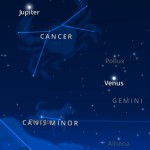Have you ever looked up into to the night sky and wondered what’s that bright object next to the Moon? Is that a star or a planet? (Spoiler: that’s likely to be Venus for the month of May, 2015)
Gone are the days of bulky telescopes, star charts, and astronomy books, now we have apps for that. I have picked a few astronomy apps we like that will help you to find the locations of stars, planets, constellations, and even satellites and space stations in real time.
These apps use the phone’s built in accelerometer, compass, and GPS to determine the celestial bodies you are looking at. Some of these apps don’t require Internet connect; that means you can use the apps in the field with no cellular, Wi-Fi, or data connection.
Sky Guide by Fifth Stars Labs – $1.99
 Sky Guide is my current favorite due to the simple and easy to use interface. The amount of additional information about the celestial bodies is unmatched. I’m also impressed by the notification system. Not only will the app remind you of astronomical events (such as meteor showers and eclipses). You can also tell the app to remind you of satellite pass by. In fact, the app keeps tracks of various man-made objects in the sky like the International Space Station. You will be notified when it is viewable in your part of the world.
Sky Guide is my current favorite due to the simple and easy to use interface. The amount of additional information about the celestial bodies is unmatched. I’m also impressed by the notification system. Not only will the app remind you of astronomical events (such as meteor showers and eclipses). You can also tell the app to remind you of satellite pass by. In fact, the app keeps tracks of various man-made objects in the sky like the International Space Station. You will be notified when it is viewable in your part of the world.
SkyView Free by Terminal Eleven LLC – Free
 SkyView provides an AR (augmented reality) view of the night sky via the phone’s camera. Instead of pointing the app next to the celestial bodies, SkyView lets you “overlay” the information by looking through the phone’s camera. The app also superimposes planetary images on the screen to give you an idea on planetary body you are looking at.
SkyView provides an AR (augmented reality) view of the night sky via the phone’s camera. Instead of pointing the app next to the celestial bodies, SkyView lets you “overlay” the information by looking through the phone’s camera. The app also superimposes planetary images on the screen to give you an idea on planetary body you are looking at.
Star Walk 2 by Vito Technology – $2.99 with additional in-app purchase
 I own the original version of Star Walk, and Star Walk 2 has a complete redesign interface and is much easier to use. What makes Star Walk 2 stand out is the heavy use of 3D graphics within the app. The 3D content is simply very pleasant to look at and done in a great style.
I own the original version of Star Walk, and Star Walk 2 has a complete redesign interface and is much easier to use. What makes Star Walk 2 stand out is the heavy use of 3D graphics within the app. The 3D content is simply very pleasant to look at and done in a great style.
Note that, additional content such as satellites locations requires additional in-app purchases and the app is also available on other smartphone platforms such as Android OS and Windows Phone.
Starlight by Gyrocade – $0.99
 If you need something very basic then I would recommend Starlight.
If you need something very basic then I would recommend Starlight.
Just like the apps I mentioned above, Starlight uses the phone’s built in accelerometer, compass, and GPS to determine the celestial bodies you are looking at. Starlight is especially good at identifying Constellations in the sky and putting that up front and center. I would recommend this app to any users who are especially interested in zodiac signs and related mythology.
Bonus:
Upcoming Astronomical Events for the month of June 2015 visible to the naked eye:
June 6 – Venus at Greatest Eastern Elongation. The planet Venus reaches greatest eastern elongation of 45.4 degrees from the Sun. This is the best time to view Venus since it will be at its highest point above the horizon in the evening sky. Look for the bright planet in the western sky after sunset.
June 24 – Mercury at Greatest Western Elongation. The planet Mercury reaches greatest western elongation of 22.5 degrees from the Sun. This is the best time to view Mercury since it will be at its highest point above the horizon in the morning sky. Look for the planet low in the eastern sky just before sunrise.



